How Do Binoculars Work? Explained
Last Updated on
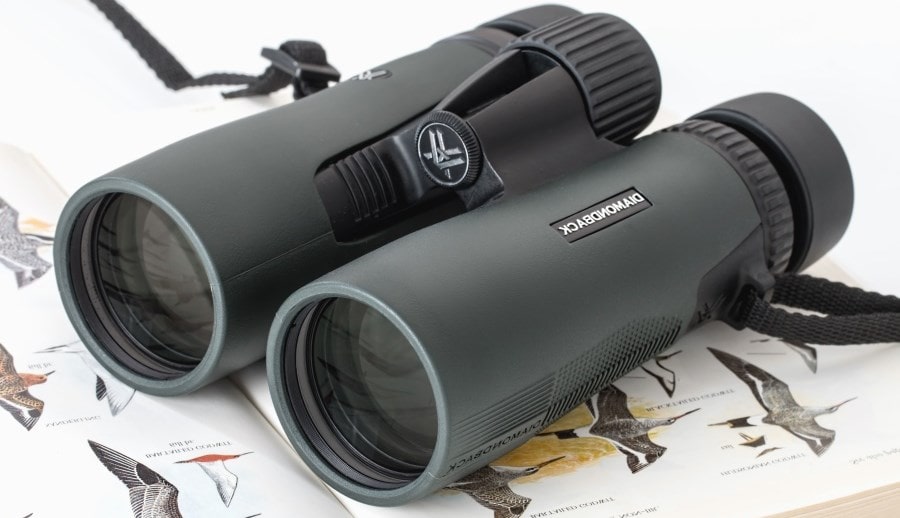
Binoculars are a useful tool with a diverse array of applications as far-flung as hunting, sporting events, birding, and surveillance. Their list of uses has almost no end, and they’ve been employed in almost every hobby and outdoor activity there is.
These tools allow us to see far distances with incredible detail. But just how do they work? How exactly does this little device magnify a distant image and make it visible to us as if it were close?
Let’s take a look at just how those lenses magnify an image and present us with a clear and crisp viewing experience. While we’re at it, let’s discuss the different types of binoculars, what separates them, and all of the important things you need to know about buying and using binoculars.
Telescopes can only be viewed with a single eye, but humans have two. So naturally, someone decided to put two small telescopes together and create the first pair of functional binoculars. That someone was J.P. Lemiere, a French inventor. That first patent was applied for in 1825, but it took an additional 29 years before the Porro prism system we use today was patented and put into circulation. This was the start of modern binoculars. Brief History of Binoculars
When the first telescope was invented in 1609, it opened up a world of possibilities for human sight. Suddenly, we could see farther and clearer than ever before. But this was just the start.
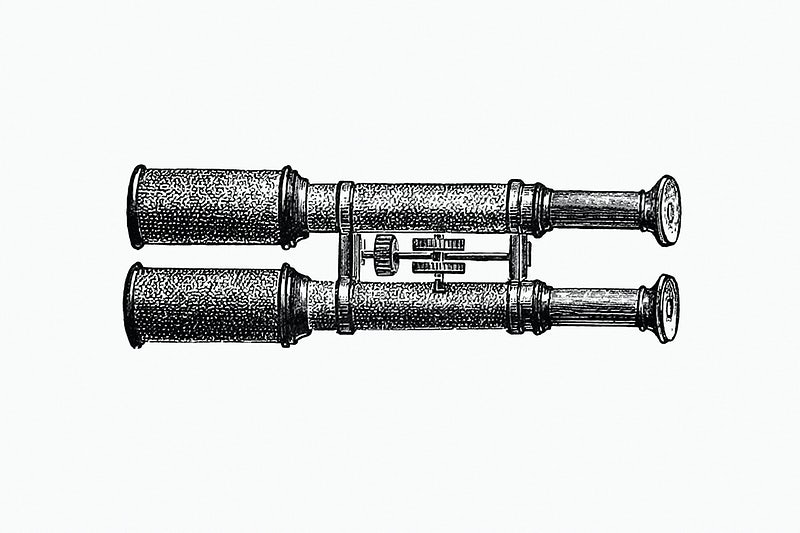
How Do Binoculars Work?
In essence, binoculars are two small telescopes mounted side by side. They’re hinged in the center so they can be separated and closed to fit different sized faces.
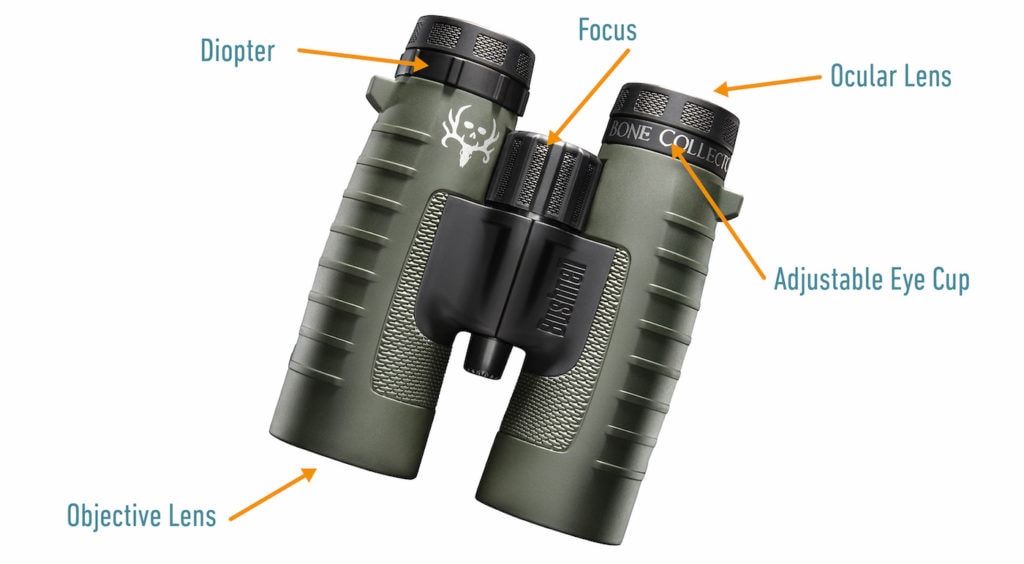
Put simply, the objective lens takes in light and captures an image. The second lens, the eyepiece lens, magnifies the image so that it’s clearer for your eye.
Let’s take a closer look at each part of this process to get a fuller picture of how binoculars function.
Light Refraction
Light refraction is the way light bends when it goes through different materials, such as the glass in the objective lens in a set of binoculars. The light bends or refracts as it goes through the objective lens. By altering the objective lens, binoculars manufacturers can control the light.

Lenses & Magnification
In a convex lens like an objective lens, the middle is thicker than the sides. This causes the light to refract in towards the middle, allowing the lens to focus distant rays of light into a small image that’s projected a short distance away.
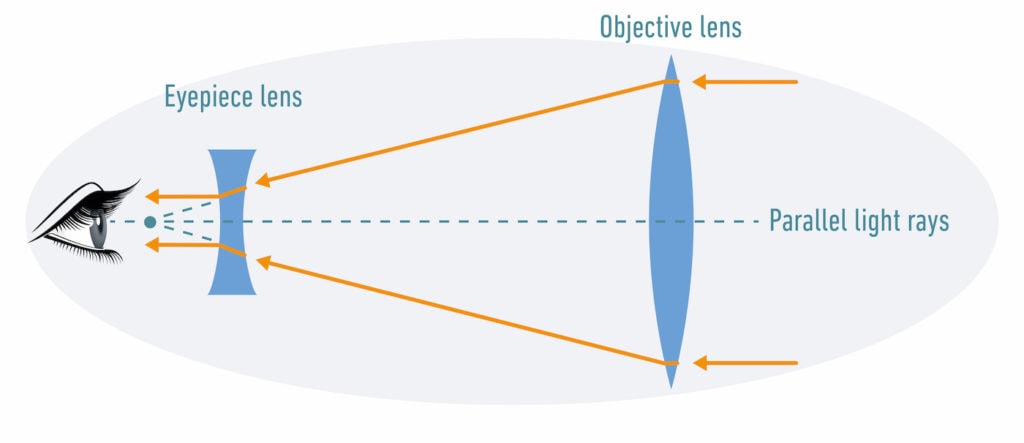
The eyepiece lens can be thought of as a magnifying glass, expanding the small image it picks up into a larger one for you to view. This lens will take the image that’s projected onto it by the objective lens and magnify it for your viewing pleasure.
Prisms
There’s one problem with using these convex lenses to refract light. When light is refracted through a convex lens, the light rays can cross over, resulting in an upside-down image. You might think the eyepiece lens takes care of this issue, but it doesn’t.
Instead, prisms are employed to rotate the image for your eyes. These prisms are essentially just large wedges of glass that rotate and reflect the image. It takes two prisms to rotate the image 180 degrees, each prism effectively rotating the image 90 degrees.
Since it takes two prisms in each tube to correct the image, each set of binoculars will have four total prisms.
Porro prisms are more common, more affordable, and much older than roof prisms. They’re the original design used in the first modern binoculars that eventually grew into the tools we use today. But they also make for bigger, bulkier binoculars. Roof prism binoculars are more compact and portable but also tend to be more expensive. Porro Prisms Porro prisms are arranged horizontally, side by side at 90 degrees. This allows the image to refract from one prism into the other. This technology is very old and has been used for centuries. Because they’re arranged horizontally, Porro prism binoculars are much larger and bulkier. But they’re also simpler to build, so they usually cost less than roof prism binoculars. But those prisms are also easier to knock out of alignment. A drop can destroy a set of Porro prism binoculars when it might not destroy a set of roof prisms. Likewise, many Porro prism binoculars are not waterproof or weatherproof. Roof Prisms Roof prisms are set in a straight line instead of being set beside each other. This allows for a more compact and streamlined set of binoculars. You might think this means that the light takes a straight path as well, but the path the light follows is much more complicated in roof prism binoculars since it must refract around the prisms and come back into a straight line for you to view. This also means a longer focal path, resulting in greater magnification. But these prisms are more complex and harder to manufacture, which means that roof prism binoculars are generally more expensive. They also tend to be more durable since the prisms are arranged in a straight line and they don’t knock out of alignment quite as easily. Porro vs Roof Prisms
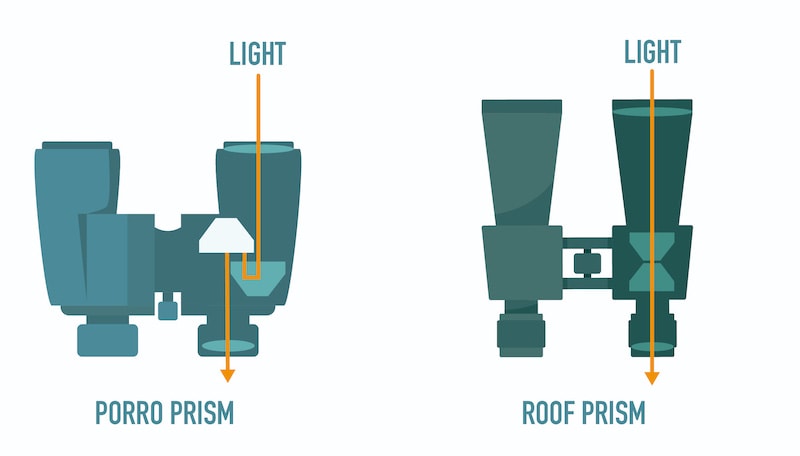
Focus
On most binoculars, you’ll find a large center ring that can spin to focus the barrels simultaneously. This is great for quickly focusing in on a subject and getting a clear image without much hassle.

Many binoculars also include a diopter adjustment ring that allows you to focus one barrel separately from the other. This lets you compensate for differences between your eyes and allows you to dial in the sharpest most focused image possible.
Field of View
Field of view represents how much area you’re actually viewing. It’s a measure of how many feet across you’re able to see through your device, measured at 1,000 yards.
In general, higher magnification means a smaller field of view. As you’re zoomed in with higher magnification, you’ll be able to see a smaller area overall, but you’ll get a more detailed view.
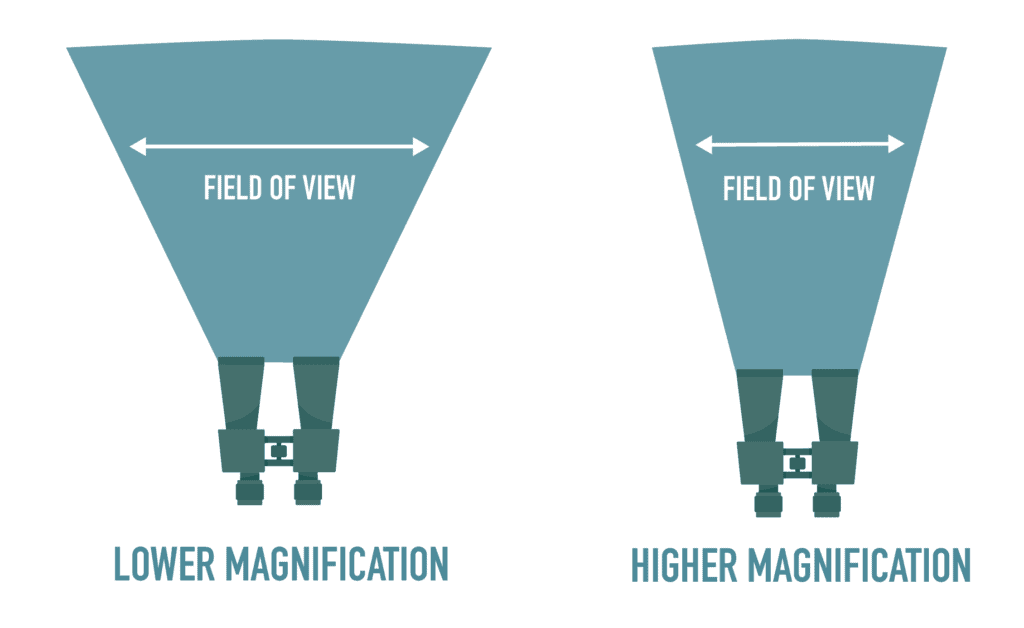
When dealing with lower magnification, you might not see as much detail, but you’ll be taking in a lot more area at once.
A larger field of view is great for locating targets that are hard to see or moving. This is perfect for birding, nature watching, or for hunters trying to locate their prey.
When the field of view is small, you’ll get a detailed look at a small area. This is great for surveillance activities, hunters watching their prey once located, and for birders trying to get an up-close look at a far off avian subject.
Eye Relief
If you don’t know how binoculars you work, you might attempt to stick the eyepieces directly against your eyes. But you’re actually supposed to hold them a short distance from your face so that the entire field of view is visible. The exact distance you’re meant to hold them from your eye is called the eye relief.
This spec is most important if you wear glasses or other eyewear. If the eye relief is too small, you won’t have room to get close enough to see the whole image without your glasses hitting the eyepieces. For glasses wearers, you’ll want to find binoculars with a minimum of 11 millimeters of eye relief.
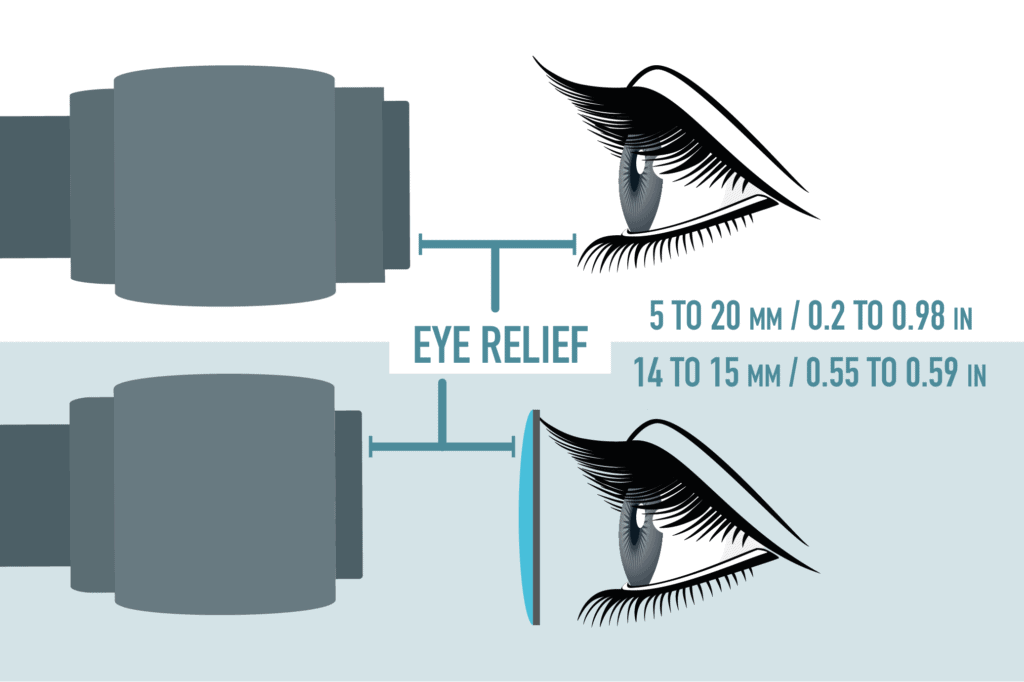
Some binoculars have adjustable eyepieces. These will let you set the eye relief to wherever is most comfortable for you. Just make sure the maximum eye relief is at least 11 millimeters if you’re wearing glasses and these should suit you fine.
Exit Pupil
The width of the light beam coming through the eyepiece is called the exit pupil. If you hold the binoculars a distance from your face, you’ll see the exit pupil as a small round dot of light in the eyepieces.
In general, a larger exit pupil is better. The bigger the exit pupil, the brighter the image you’ll see. This is especially important in low-light conditions where a small exit pupil can prevent you from seeing clearly.
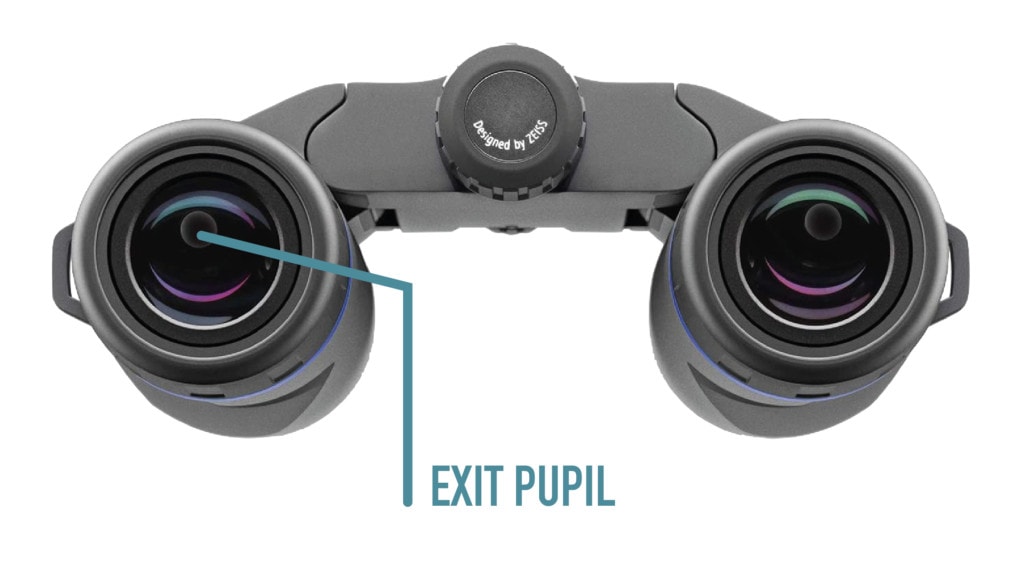
The exit pupil is easy to find for any binoculars. You simply divide the objective lens by the magnification. So, for a set of 8×42 binoculars, you’d divide 42 by 8 for an exit pupil that’s 5.25 millimeters.
Magnification The first number followed by x represents the magnification level of the binoculars. So for a set of binos that’s listed as 8×42, they’ve got 8x magnification. Similarly, 10×42 binoculars have 10x magnification, 12×25 means 12x magnification, and so on. What this means is that when you look through those 8x binoculars, whatever you see will appear eight times larger through the lenses than through your naked eye. You can also think of it as the object appearing eight times closer when viewed through your binoculars. Objective Lens The second number, the one following the x, represents the size of the objective lens in millimeters. As we mentioned, the objective lens is the lens on the end of your binoculars that takes in light and an image. In the case of 8×42 binoculars, the 42 means that the objective lenses are 42 millimeters in diameter. So the binoculars have 8x magnification with a 42-millimeter objective lens. In general, a larger objective lens lets in more light and allows for a brighter, sharper image and better low-light performance. On the other hand, it also means the binoculars will be larger and less compact, so it’s a tradeoff. What Do the Numbers on Binoculars Mean?
You’ve probably seen binoculars with different numbers on them and wondered what those numbers were supposed to signify. 8×42, 12×25, 10×42, what do they all mean? Don’t worry, you won’t have to do any math.
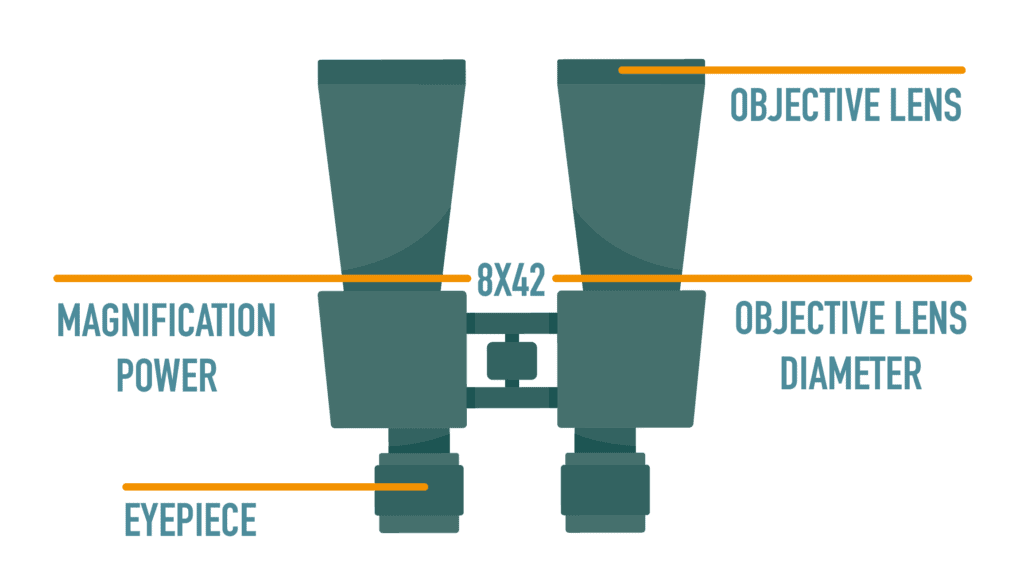
Different Sizes of Binoculars
Like everything else, size matters in binoculars. Your chosen size will depend on your intended use.

Compact Binoculars – Great for mobile adventures. Not so great for situations where magnification is required.
Midsize Binoculars – The happy medium of binos. Good to excellent magnification and the widest range of choices.
Full-size Binoculars – Best for specific situations where size isn’t an issue and power outweighs any drawbacks.
Additional Categories of Binoculars
We’ve already discussed the two main types of binoculars in detail; Porro prism and roof prism binoculars. And we’ve looked at the general sizing of binos. But there are also specialty binoculars that have specific functions. Let’s take a look at a few of them.
Foldable or Mini Binoculars
When portability is of the utmost concern, mini or foldable binoculars fold down into a small and easily transported package. They’re not generally as powerful as full-size binoculars, but they can be stuffed into cramped packs without taking up much space.

Wide Angle Binoculars
Binoculars have a pretty wide field of view to start with. But sometimes, that’s just not enough. When you need the widest field of view possible, wide-angle binoculars open up your field of view and make it possible to spot objects in large, open areas. These are great for spotting creatures or watching sporting events.
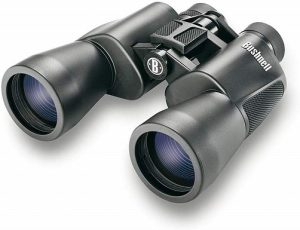
Zoom Binoculars
Just like a zoom camera, zoom binoculars let you change the magnification to get a closer or farther look at your subject. You can zoom out for a wider field of view to easily spot your subject, then zoom in for higher magnification and a more detailed, close-up look.
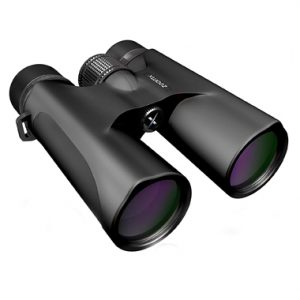
High-powered Binoculars
Often used by astronomers as a more portable alternative to telescopes, high-powered binoculars have exaggerated levels of magnification to allow you to see for very long distances. They’re big and bulky because of that extra magnification, but they’re ideal for any type of long-distance viewing.

Auto Focus Binoculars
Though they’re called auto-focusing, that’s not really the case with these tools. Instead, their depth of field is fixed, keeping everything in focus, similar to a GoPro camera. Either way, they’re always in focus, making them extremely easy to use.
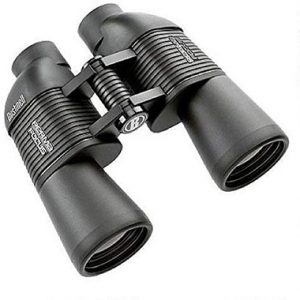
Image Stabilizing Binoculars
Image-stabilized binoculars eliminate second-guessing and reduce the effects of human error aka “image shake”. These are binoculars for active situations where movement is necessary, such as birdwatching or viewing a football game. These are also some of the most expensive specs in the genre.
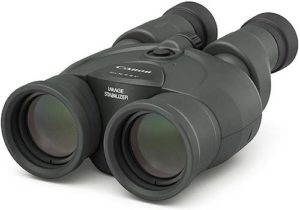
Waterproof Binoculars
If you’re using your binoculars on a rafting or kayaking trip, water-resistant just won’t do. For these situations, waterproof binoculars are essential for aquatic adventures.
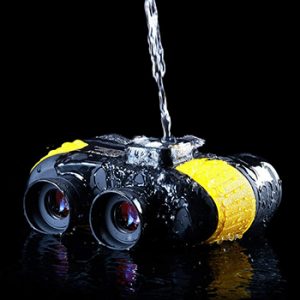
Tripod-mounted Binoculars
When your arms get tired and you’re introducing too much image shake, tripod-mounted binoculars let you screw in a traditional tripod and take the hands-free approach.
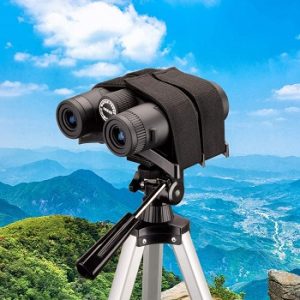
Binocular Uses & Recommendations
Binoculars are a versatile tool that is used by many people in different hobbies, past times, sports, and activities. So, who will benefit the most from binoculars?
Hunters – Hunters can use binoculars to help locate and track their prey. For hunting, a wide field of view can be a great help, making it much easier to locate prey that blends in well to its surroundings.
Sporting Events & Concerts – When you’re high up in the stands, it can be hard to see the action down below on the field. But binoculars can put you right there in the game. Look for binoculars with a wide field of view so you can see the whole game and not just one or two players at a time.
Birders – Birders need to locate small creatures that are almost always moving in vast stretches of sky and forest. A wide field of view can be helpful in locating these flying creatures, but a higher level of magnification is also great for watching them in detail. Birders would do well with a middle-of-the-road set of binoculars or even a zoom pair that will give them the best of both worlds.
Nature Watchers – Like birders, nature watchers will want a wider field of view to locate their subjects, hidden with natural camouflage. But once located, you’ll want a higher magnification to be able to see them up-close for observation. Zoom binoculars will offer you both a wide field of view and high magnification for viewing.
Stargazers – Stargazers can benefit from high-powered binoculars that will be able to see farther into the heavens. They’ll also do well with tripod-mounted binoculars. When watching the sky for hours, your arms will get exhausted holding those binoculars up to your eyes! A tripod can save your arms and keep the stargazing fun instead of turning it into exercise!
Conclusion
In basic terms, binoculars are two simple telescopes set side by side so each eye can view through one. The objective lens brings in light, capturing the image and sending it to the eyepiece lens where it gets magnified for your viewing pleasure. Along the way, prisms have to rotate the image since the light rays get crossed and the image gets flipped when it comes through your objective lens.
These prisms can be aligned horizontally if they’re Porro prisms, or they can be arranged straight if they’re roof prisms, resulting in more compact and streamlined but more expensive binoculars. Aside from roof prism and Porro prism binoculars, there are also plenty of specialty binoculars available to suit different needs, such as zoom binoculars and wide-angle binoculars.
No matter which set you pick, the basics of how they work are the same. And in the end, they all allow us to see farther than we ever could with the naked eye.
Featured Image Credit: Pat_Scrap, Pixabay
Table of Contents
About the Author Robert Sparks
Robert’s obsession with all things optical started early in life, when his optician father would bring home prototypes for Robert to play with. Nowadays, Robert is dedicated to helping others find the right optics for their needs. His hobbies include astronomy, astrophysics, and model building. Originally from Newark, NJ, he resides in Santa Fe, New Mexico, where the nighttime skies are filled with glittering stars.
Related Articles:
How to Collimate Binoculars: 9 Expert Tips
Can You Use Binoculars to Look At Stars? How to Choose the Right Pair
How to Choose Binoculars for Bird Watching: 10 Expert Tips
How to Clean a Refractor Telescope: Step-by-Step Guide
How to Clean a Telescope Eyepiece: Step-by-Step Guide
How to Clean a Rifle Scope: 8 Expert Tips
Monocular vs Telescope: Differences Explained (With Pictures)
What Is a Monocular Used For? 8 Common Functions
